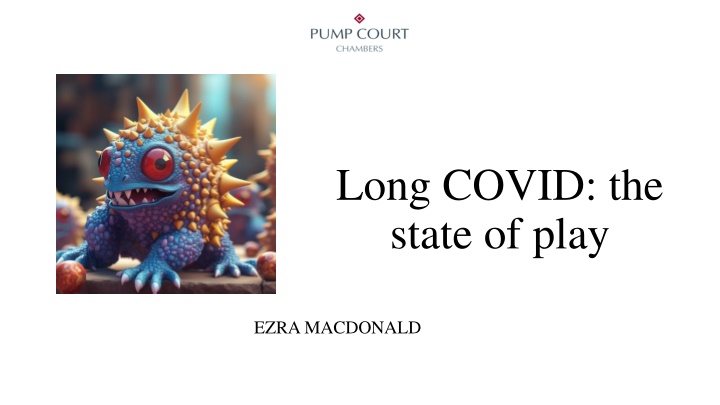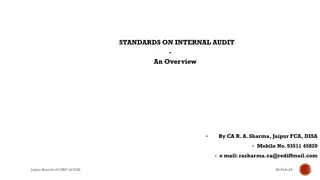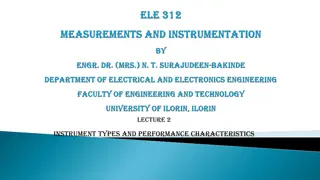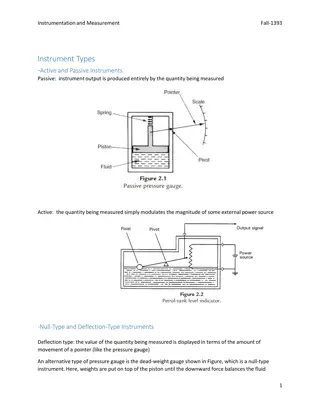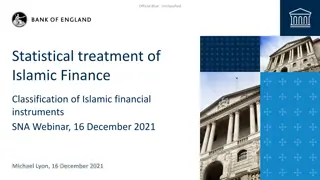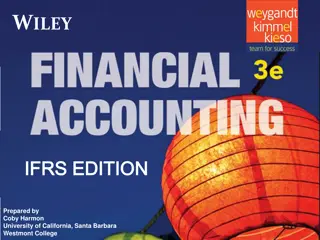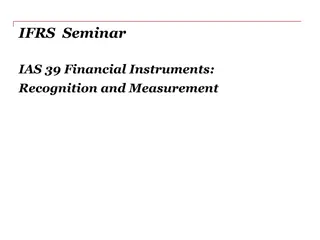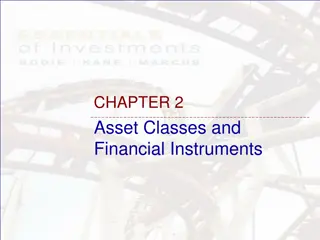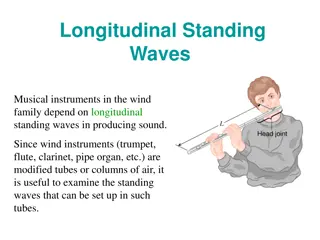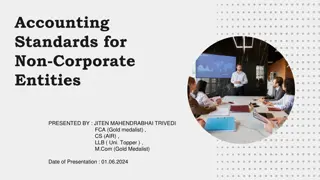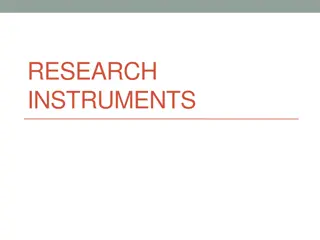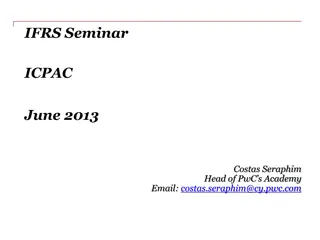Accounting for Financial Instruments and Standards Overview
This content delves into the recognition, measurement, and disclosure of financial instruments under SLFRS 9, LKAS 39, and LKAS 32. It defines financial assets, liabilities, and equity instruments, providing examples and explanations of primary types such as deposits, investments, and derivatives.
Download Presentation

Please find below an Image/Link to download the presentation.
The content on the website is provided AS IS for your information and personal use only. It may not be sold, licensed, or shared on other websites without obtaining consent from the author.If you encounter any issues during the download, it is possible that the publisher has removed the file from their server.
You are allowed to download the files provided on this website for personal or commercial use, subject to the condition that they are used lawfully. All files are the property of their respective owners.
The content on the website is provided AS IS for your information and personal use only. It may not be sold, licensed, or shared on other websites without obtaining consent from the author.
E N D
Presentation Transcript
Long COVID: the state of play EZRA MACDONALD
Long COVID =df: either Both ongoing symptomatic COVID (4-12 weeks) & post-COVID-19 syndrome (12 weeks+): NICE COVID-19 rapid guideline, or Symptoms >3 months (others) As of 5 March 2023, Long COVID symptoms adversely affected the day-to-day activities of 1.5 million people . . . with 1.9 million people experiencing self-reported Long COVID (Source: ONS)
Headlines COVID is a multi-system illness: Davis et al. (2023), including Cardiovascular; fatigue; neurologic; cognitive; pulmonary; musculoskeletal; etc. Incidence = 10-12% in vaccinated cases, per infection: Davis et al. (2023) & Bowe et al. (2022) If symptomatic at 2 months, 85% probability symptomatic at 1 year: Tran et al. (2022) (caveat emptor) Symptoms can last for years. Cases of new-onset ME/CFS & dysautonomia are expected to be lifelong: Davis et al. (2023) The risk is cumulative: Al-Aly et al. (2022)
ONS data Of people with self-reported long COVID, 1.3 million (69%) first had or suspected that they had COVID-19 at least one year previously . . . . . . 764,200 (41%) first had or suspected that they had COVID-19 at least two years previously Half a million more people are now out of the labour force because of long-term sickness (up from 2 million in 2019 to 2.5 million in June & August 2022). NB likely now to be an underestimate. BBC: 10K NHS staff off with Long COVID Institute for Fiscal Studies: 110K missing from work due to Long COVID
Statistics from New York State Insurance Fund Majority of Long COVID insurance claimants in NY (2020 2022) were <60 years of age Nearly 75% were out of work for 6 months or more Over 18% of claimants had not returned to work 1 year after infection
Curiosities of Long COVID symptoms Symptoms can be hugely diverse: see the Davis et al. paper. However, the most common symptoms reported to the ONS are: Fatigue (72% of respondents ) Difficulty concentrating (51% of respondents) Muscle ache (49% of respondents) Shortness of breath (48% of respondents) Post-exertional malaise is common, but poorly-understood. =df. inability to recover after expending even small amounts of energy. In practical terms, work can worsen symptoms.
Question: is long COVID a disability? 6 Disability (1)Aperson (P) has a disability if (a) P has a physical or mental impairment, and (b) the impairment has a substantial and long-term adverse effect on P's ability to carry out normal day- to-day activities. This is to be read in conjunction with Schedule 1 . . .
Schedule 1 Equality Act 2010 Long-term effects 2(1) The effect of an impairment is long-term if (a) it has lasted for at least 12 months, (b) it is likely to last for at least 12 months, or (c) it is likely to last for the rest of the life of the person affected. (2) If an impairment ceases to have a substantial adverse effect on a person's ability to carry out normal day-to-day activities, it is to be treated as continuing to have that effect if that effect is likely to recur. Likely to means could well : SCA Packaging Ltd v Boyle [2009] UKHL 37
So: Fact sensitive, but Probable that Long COVID will amount to a disability at the point of diagnosis (and arguably post-viral syndrome even prior to that point) In common parlance: there s a 10% chance that symptoms will persist for >3 months, and a large proportion of those affected (c. 18 25%) will be symptomatic at 1 year (hence could well last . . . )
Matthews v CGI IT UK Ltd 2203746/2021 EJ Burns, London Central ET The impairment found was long COVID The symptoms were primarily fatigue + musculo-skeletal pain and weakness The impairment began when C caught COVID-19 At four months post-infection, the impairment was likely to last at least 12 months EJ Burns took judicial notice of the fact that viruses can trigger long-term ill-health in some people and stated I see no reason why [C s] doctor would have been willing [at 4 months] to discount the reasonable possibility that the effects would continue for at least another 8 months
Hepworth v Pettit and ors 1400676/22 EJ Cuthbert, Bristol ET C was disabled by reason of fatigue, shortness of breath and mobility difficulties potentially attributable to Long COVID , from the point of referral to the Long COVID clinic, because at that point there must have been . . . a real possibility that [C] may have Long COVID . . . (satisfying the likely to last condition)
Anrude v ACAS case no. 2207635/2021 EJ Stout, London Central ET R quite sensibly conceded that Long COVID amounted to a disability within the meaning of s 6 . . . . . . but denied knowledge of the substantial disadvantages for which C contended for the purposes of her claims ACAS subsequently lost on liability, in particular by i) failing to allow C to have a phased RTW as recommended by her GP and ii) failing to allow accompaniment to RTW meetings, being failures to make reasonable adjustments & breaches of s 15 Equality Act 2010
Aruho v University College London Hospitals NHS Foundation Trust case no. 2204810/2021 EJ Nicolle, London Central ET C failed on the likely to last test re: disability for the impairment of Long COVID Query the application of the test in SCA Packaging v Boyle: see the Reasons at paras 121 124: [m]any people experience symptoms after Covid for weeks or months but then recover . . . [t]he burden is on [C] . . . [w]e do not consider that he has satisfied this burden . . . We do not consider that it could be said that it was likely that [the symptoms] would persist at least 12 months . . .
Ibrahim v Chief Constable of Gwent Police case no. 1600132/2022 EJ R Brace, Cardiff ET R conceded that Long COVID amounted to a disability but denied knowledge of how long the symptoms were going to last Held: R had constructive knowledge that substantial adverse effects could well last at least 12 months from the date of the receipt of the Occupational Health Report
Bradley v Cultureshift Communications Limited case no. 24015128/2021 EJ Shotter (sitting alone), Liverpool ET Held: C was disabled with an impairment of anxiety and depression, lethargy and tiredness associated with long covid in the relevant period . . . NB in that case the relevant period post-dated the infection by some 9 months (hence the likely to last test was met)
Williams v DVLA case no. 1600521/2022 EJ Othen, Wales ET (by CVP) Held: C was disabled at the material time by virtue of inter alia Long COVID No reasons available Turning now to reasonable adjustments . . .
Note the knowledge limitation for reasonable adjustments: Schedule 8 Equality Act 2010 PART 3 LIMITATIONSONTHEDUTY Lack of knowledge of disability, etc. 20(1) A is not subject to a duty to make reasonable adjustments if A does not know, and could not reasonably be expected to know [. . .] (b) In any case referred to in Part 2 of this Schedule, that an interested disabled person has a disability and is likely to be placed at the disadvantage referred to in the first, second or third requirement.
Reasonable adjustments To trigger the reasonableadjustments duty, it is essential to make sure the employer has at least constructive knowledge of both the fact of disability and the alleged disadvantage(s). The question what adjustment is required is highly fact-specific. NB again that Long COVID is multi-system and will therefore present differently in different individuals. Example reasonable adjustments might be: Reduced working hours for an employee suffering fatigue Altered place of work for an employee no longer able to drive Altered performance targets for an employee with disordered sleep, memory loss, etc.
Indirect discrimination S 19 Equality Act 2010 (1) A person (A) discriminates against another (B) if A applies to B a provision, criterion or practice which is discriminatory in relation to a relevant protected characteristic of B's. (2) For the purposes of subsection (1), a provision, criterion or practice is discriminatory in relation to a relevant protected characteristic of B's if (a) A applies, or would apply, it to persons with whom B does not share the characteristic, (b) it puts, or would put, persons with whom B shares the characteristic at a particular disadvantage when compared with persons with whom B does not share it, (c) it puts, or would put, B at that disadvantage, and (d) A cannot show it to be a proportionate means of achieving a legitimate aim. (3) The relevant protected characteristics are [age, disability . . . race . . . sex]
Does a failure to impose workplace mitigations amount to indirect discrimination? ACAS: Long Covid advice for employers and employees Long covid has been found to more severely affect: older people ethnic minorities Women NB the ONS adds those with another . . . disability
Workplace mitigations? HEPA filtration Working from home Ventilation Air purification (Electrostatic Precipitators, UV, etc) PPE, e.g. FFP3 respirators (especially in healthcare settings) NB upgraded air filtration solutions have been installed in the Palace of Westminster; the Ministry of Defence; and an arm of the Government located nationwide . . . . . . so are presumably considered to be effective, and cost-effective (Source: Purified Air Ltd website)
So: Failure to introduce workplace mitigations will put older people; ethnic minorities; women; those with another disability at a particular disadvantage in comparison with those who do not share the protected characteristic in question. Particular disadvantage: increased risk of Long COVID / increased risk of being out of work / etc. Therefore: there is a risk that failure to introduce workplace mitigations could amount to indirect discrimination (subject of course to objective justification) That in turn raises an interesting question about personal injury
Personal injury claims in the ET Can be claimed: Sheriff v Klyne Tugs (Lowestoft) Ltd [1999] IRLR 481 Causation will be an issue: Fraser v Crown Prosecution Service UKEAT/0021/13 (and will be a serious issue if the injury flows from COVID-19 infection, for obvious reasons) Can mitigations be shown to prevent COVID-19 infection? Yes: Addenbrooke s Hospital in Cambridge upgraded face masks for staff working on COVID-19 wards to FFP3 respirators, resulting in a fall of up to 100% in hospital-acquired SARS-CoV-2 infections among those staff: Ferris, M, Ferris, R et al. FFP3 respirators protect healthcare workers against infection with SARS- CoV-2. DOI: 10.22541/au.162454911.17263721/v1 For healthcare workers, at least, the point is worth considering
Dont forget harassment! 26 Harassment (1) A person (A) harasses another (B) if (a) A engages in unwanted conduct related to a relevant protected characteristic, and (b) the conduct has the purpose or effect of (i) violating B's dignity, or (ii) creating an intimidating, hostile, degrading, humiliating or offensive environment for B. [. . .] (4) In deciding whether conduct has the effect referred to in subsection (1)(b), each of the following must be taken into account (a) the perception of B; (b) the other circumstances of the case; (c) whether it is reasonable for the conduct to have that effect.
Simon Evans, The News Quiz, BBC R4, 28 May 2023 Let s be honest, it s never very hard to guess who s going to get [Long COVID] is it? Know what I mean?
The reasonable steps defence: s 109 EA 2010 109 (1) Anything done by a person (A) in the course of A's employment must be treated as also done by the employer. (2) Anything done by an agent for a principal, with the authority of the principal, must be treated as also done by the principal. (3) approval. It does not matter whether that thing is done with the employer's or principal's knowledge or (4) In proceedings against A's employer (B) in respect of anything alleged to have been done by A in the course of A's employment it is a defence for B to show that B took all reasonable steps to prevent A (a) from doing that thing, or (b) from doing anything of that description.
Reasonable steps (cont.) Two-stage approach: First, ask what steps the employer took Then, ask whether there were other reasonable steps it could have taken Key authorities: Canniffe v East Riding of Yorkshire Council 2000 IRLR 555 Allay (UK) Ltd v Gehlen [2021] ICR 645 ( stale training was not effective to prevent harassment; refresher training would have been a reasonable step) Caspersz v Ministry of Defence UKEAT/0599/05 (not enough to show that a relevant policy exists; the employer also needs to show that it is implemented)
Resources 1. Workers Experiences of Long Covid: a joint report by the TUC and Long Covid Support (March 2023) 2. ACAS (of course) 3. ONS (in relation to long COVID symptoms) and ONS (in relation to working-age adults out of the labour market due to long-term sickness) 4. Al-Aly, A., Bowe, B. & Xie, Y. (2022) Long Covid after breakthrough SARS-CoV-2 infection Nature Medicine Vol 28, pp 1461-1467 5. Bowe, B., Xie, Y. & Al-Aly, A. (2022) Acute and postacute sequelae associated with SARS-CoV-2 reinfection. Nature Medicine Vol 28, pp 2398 2406 6. Davis, H. E., McCorkell, L., Vogel, J. M., & Topol, E. J. (2023) Long COVID: major findings, mechanisms and recommendations. Nature Reviews Microbiology Vol 21, pp 133 146. 7. Tran, V-T., Porcher, R., Pane, I., & Ravaud, P. (2022) Course of post COVID-19 disease symptoms over time in the ComPaRe long COVID prospective e-cohort. Nature Communications (2022):13:1812 https://doi.org/10.1038/s41467-022-29513-z
